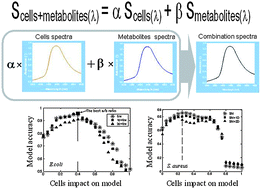Extracellular metabolites play a dominant role in near-infrared spectroscopic quantification of bacteria at food-safety level concentrations
Abstract

Maintenance work is planned for Wednesday 1st May 2024 from 9:00am to 11:00am (BST).
During this time, the performance of our website may be affected - searches may run slowly and some pages may be temporarily unavailable. If this happens, please try refreshing your web browser or try waiting two to three minutes before trying again.
We apologise for any inconvenience this might cause and thank you for your patience.
* Corresponding authors
a
Biomeasurement Technology Laboratory, Faculty of Agriculture, Kobe University, Rokkodai cho 1-1, Nada ku, Kobe 657 8501, Japan
E-mail:
rtsen@kobe-u.ac.jp
Fax: +81 78 803 5911
Tel: +81 78 803 5911
b
Division of Biological Science, Faculty of Science, Nagoya University, Furo-cho, Chikusa-ku, Nagoya 464-8601, Japan
E-mail:
mnvassileva@bio.nagoya-u.ac.jp
Fax: +81 52 789 3530
Tel: +81 52 789 3530
c
Department of Food Safety and Control, Faculty of Veterinary Medicine, Trakia University, Stara Zagora 6000, Bulgaria
E-mail:
todor.stoyanchev@uni-sz.bg
Fax: +359 42 670 624
Tel: +359 42 699 540
d
Department of Bioresource Science, Faculty of Agriculture, Kobe University, Rokkodai cho 1-1, Nada ku, Kobe 657 8501, Japan
E-mail:
tamie@opal.kobe-u.ac.jp
Fax: +81 78 803 5804
Tel: +81 78 803 5804

 Please wait while we load your content...
Something went wrong. Try again?
Please wait while we load your content...
Something went wrong. Try again?
Y. Nakakimura, M. Vassileva, T. Stoyanchev, K. Nakai, R. Osawa, J. Kawano and R. Tsenkova, Anal. Methods, 2012, 4, 1389 DOI: 10.1039/C2AY05771A
To request permission to reproduce material from this article, please go to the Copyright Clearance Center request page.
If you are an author contributing to an RSC publication, you do not need to request permission provided correct acknowledgement is given.
If you are the author of this article, you do not need to request permission to reproduce figures and diagrams provided correct acknowledgement is given. If you want to reproduce the whole article in a third-party publication (excluding your thesis/dissertation for which permission is not required) please go to the Copyright Clearance Center request page.
Read more about how to correctly acknowledge RSC content.
 Fetching data from CrossRef.
Fetching data from CrossRef.
This may take some time to load.
Loading related content
